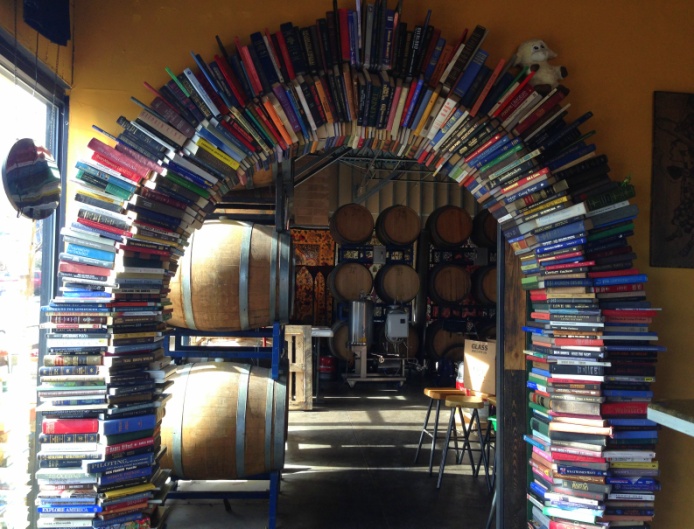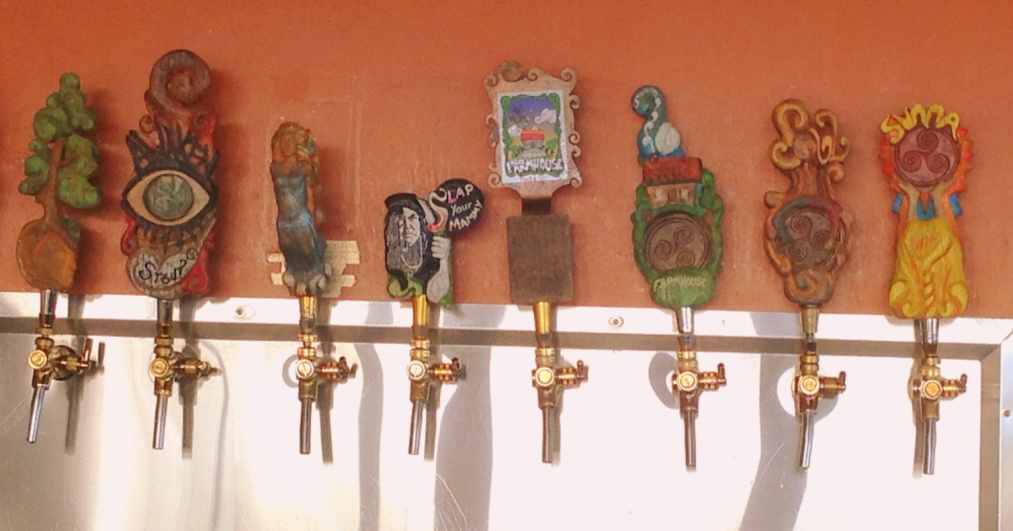By Robin Coxe

The Backstory
On Thursday evenings, I emerge from the electrical engineering nerd cave in which I spend most of my waking hours and moonlight as a volunteer bartender. Yes, such a thing actually exists. I dispense alcoholic beverages to those with an entrepreneurial bent gratis out of the goodness in my heart. Inspired by the eponymous 2002 book by Teresa Esser, the Venture Café is a networking event featuring free craft beer and wine for the Boston-area startup community that takes place every Thursday from 3-8 pm sponsored by Cambridge Innovation Center in Kendall Square, home to several hundred early-stage tech companies. The brainchild of Tim Rowe, CEO of CIC, and Carrie Stalder, a MIT Sloan graduate and former aerospace engineer, the Venture Café began operations in 2010.
I first heard about the Venture Café through the startup grapevine soon after moving back to Boston from Los Angeles. Although hobnobbing is hardly my strong suit, I somehow managed to secure several consulting contracts, one of which eventually morphed into my current job with a CIC client company, as a consequence of fortuitous conversations with people that I met at the Café. After I had gotten the lay of the land and established myself in the community, I felt impelled to do some small part to ensure that others could continue to benefit from the unique environment of Venture Café.
The first test of worthiness for all new Venture Café volunteers is to take some greeter shifts. A visitor to the Café enters his or her email address and a password or authenticates with a CIC keycard on a laptop at a kiosk set up in the hallway next to the 5th floor elevator bay. The sign-in app enables attendees to connect their LinkedIn profiles to their Venture Café accounts and to log on to the website and view the other guests at the Café on any given week. Greeters shepherd people through the sign-in process, check IDs and stamp hands of those of legal drinking age, explain the Venture Café concept to newbies, and give rundowns on the weekly schedule of the events. If the process proceeds according to plan, a label printer disgorges nametags with a number in parentheses indicating the number of times individuals have attended the Café.
When I informed my father that I was embarking on this endeavor, his response was, “I’m glad to hear it. That means that you’ll actually have to talk to people.” Basking in the warm glow of parental support, I did my time as a greeter for several months. Suffice it to say that it was a character-building experience and there is a damn good reason that I am not a hostess at a chain restaurant. At this point, I may well be the world expert at debugging the label printers. Ankle surgery necessitated a several month hiatus from volunteering at Venture Café in the winter and spring of 2012.
One day while I was still wearing The Boot on my left foot and clomping around on crutches with a thermos of Peet’s French roast strapped to my back, I learned that CIC was offering ServeSafe training for Café volunteers interested in becoming qualified as bartenders. On a whim, I signed up. Our instructor, a jocular off-duty cop from Quincy, ensured that we all passed the multiple-choice test with flying colors after watching unintentionally comedic video vignettes on one’s responsibilities and potential liabilities as a bartender. I’m convinced that the training videos featured the same C-list actors as the Foreign Corrupt Practices Act webinar that the Legal Department made me watch exhorting me not to bribe foreign officials. The ServeSafe takeaway: bartenders can be held personally liable for mayhem wrought by patrons we have over-served. Consequently, we have the right to refuse service at our discretion, but drunk people can be volatile, so having large men around and 911 on speed dial has the potential to make our lives easier.
Several weeks later, certification in hand, I took the plunge and signed up for a bar shift. Amy, Greg, and Shahin showed me the ropes—how to avoid pouring a cup of foam, how to change an empty keg, how to strategically position kegs and white wine in the kegerator, etc. I soon discovered that I had joined what is undoubtedly the most overeducated bartending team in Greater Boston, or possibly the entire universe. Between the four of us, we have 3 Ph.D.s in science and engineering, a J.D., and a masters degree in neuroscience.
In spite of, or perhaps because of 3 degrees in physics, when I first stepped behind the bar, I knew next to nothing about beer other than I liked most of it. Nuggets of wisdom imparted by Venture Café Bar Manager and beer geek extraordinaire Amy, some strategic book purchases on Amazon, a subscription to Beer Advocate, and liberal sampling of the beer on offer soon rectified that situation. However, given that I have a vast preference for malt and hops over fermented grape juice, my general ignorance of wine persists. I have only the vaguest notion of how (or if) wankerish wine-speak translates into flavor sensations. I am of the general opinion that the wine we serve tastes like swill, which may or may not actually be true. I discovered at the Wine Expo earlier this year that I have a penchant for expensive wine. Budgetary constraints dictate that all of the wine at Venture Café must cost less than $10/bottle, which could explain a lot. When people ask me for wine recommendations, my magic formula involves picking randomly and endorsing emphatically. No one has ever complained.
Although hardly surprising in hindsight, the most revelatory aspect of this volunteer bartending gig has been the often snark-inducing and occasionally downright bizarre observations of human behavior under the influence of moderate amounts of alcohol.
Uncommon Courtesy
In my experience, rudeness to people in service professions tends to indicate a misplaced sense of entitlement and an excessive self-regard. But before stepping behind the bar at Venture Café, I had only infrequently been on the receiving end of blatant impoliteness of this nature. Although we have never taken an exact count, I estimate that less than 40% of people who come up to the bar for a beverage bother to say “please” and/or “thank you.” When someone fails Politeness 101, the first thought that pops into my head is: “Who are your parents?” followed by flashbacks to the late 1970’s of my mother’s withering stares when my brother and I failed to mind our manners.
To make a sweeping, yet accurate generalization, women are, on average, significantly more polite than men. (On a typical Thursday, approximately 70-80% of the visitors are male.) The rudest ones tend to be either between the ages of 21 and 28 or over 50. Every week, at least five of the most egregious offenders cannot even bring themselves to ask for a specific beer. They grunt incomprehensibly and point, often ambiguously, at one of the taps. It would be much more entertaining for yours truly if they could at least come out with: “Me caveman. Me want beer! Ooga wooga!” One day, after an unusually long string of verbally challenged patrons, I exclaimed, exasperated: “Use your words!”
Sometimes when the Café gets very crowded (around 6 pm on sunny days when venture capitalists are holding office hours or some organization is sponsoring food), the frenzied din of conversation makes it difficult to hear people when they actually do speak up and order a drink. I can provide one piece of helpful advice to Café patrons in such a situation: repeating the name of the wine you would like in a bad French accent at increasingly high volume will not help your cause.
The under-30 set seems to favor the direct, yet boorish method of ordering beer: “Give me a Slumbrew IPA.” Sometimes, I am tempted to answer: “No.” I restrain myself, but usually cannot fully suppress an incredulous look as I hand over the beer. The percentage of the recipients who say thank you is in the single digits after demanding a beer in this manner.
Some of our more recalcitrant visitors have been brainwashed by the marketing machines of the likes of Miller-Coors and Anheuser-Bush InBev into believing that mass-produced light lagers constitute good beer. One day about 3 months ago, a gentleman in his mid-50s walked up to the bar and declared: “None of the beer you serve satisfies me.” As it happened, it was his lucky day. A Dutch economic development organization had sponsored a portion of the beer that day. “I’m sorry to hear that. Here, have a Heine,” I said, working very hard to keep my eyebrows from spontaneously raising themselves. He beamed and responded: “That’s more like it!” Whatever floats your boat, I suppose.
At least twice a day, a younger guy asks for a porter or a stout without knowing that these dark brews tend to be full-bodied and have strong flavor profiles. He skulks back to the bar several minutes later with a disgusted look on his face, deposits his almost-full Vegware cup on the bar, and says something to the effect of: “This beer is undrinkable. Take it back and give me something else.” To which I reply, “Here, have our lightest beer… You’re welcome!”
Pro Tip: if you want a bartender to like you, don’t be a jackass.










































